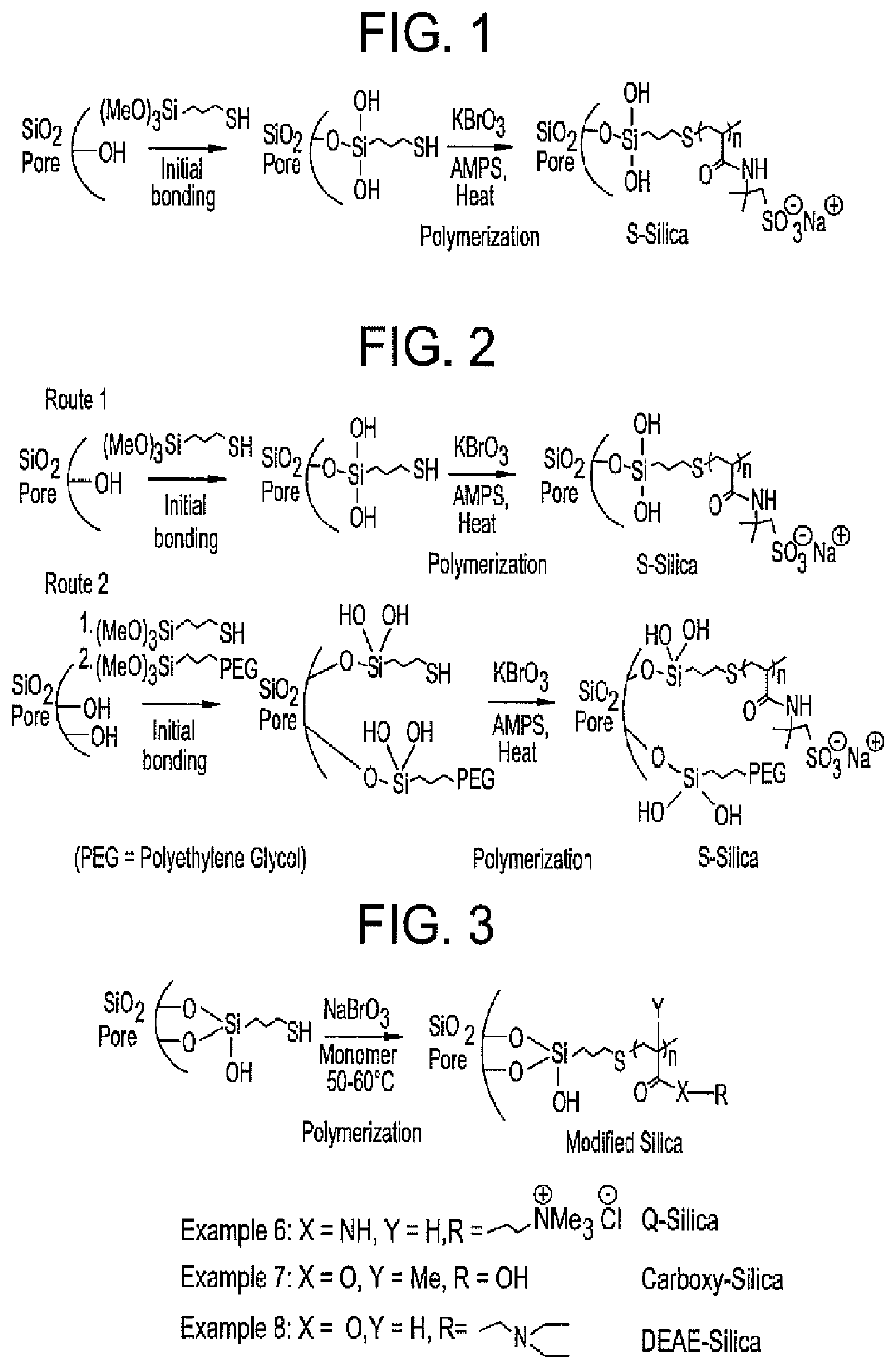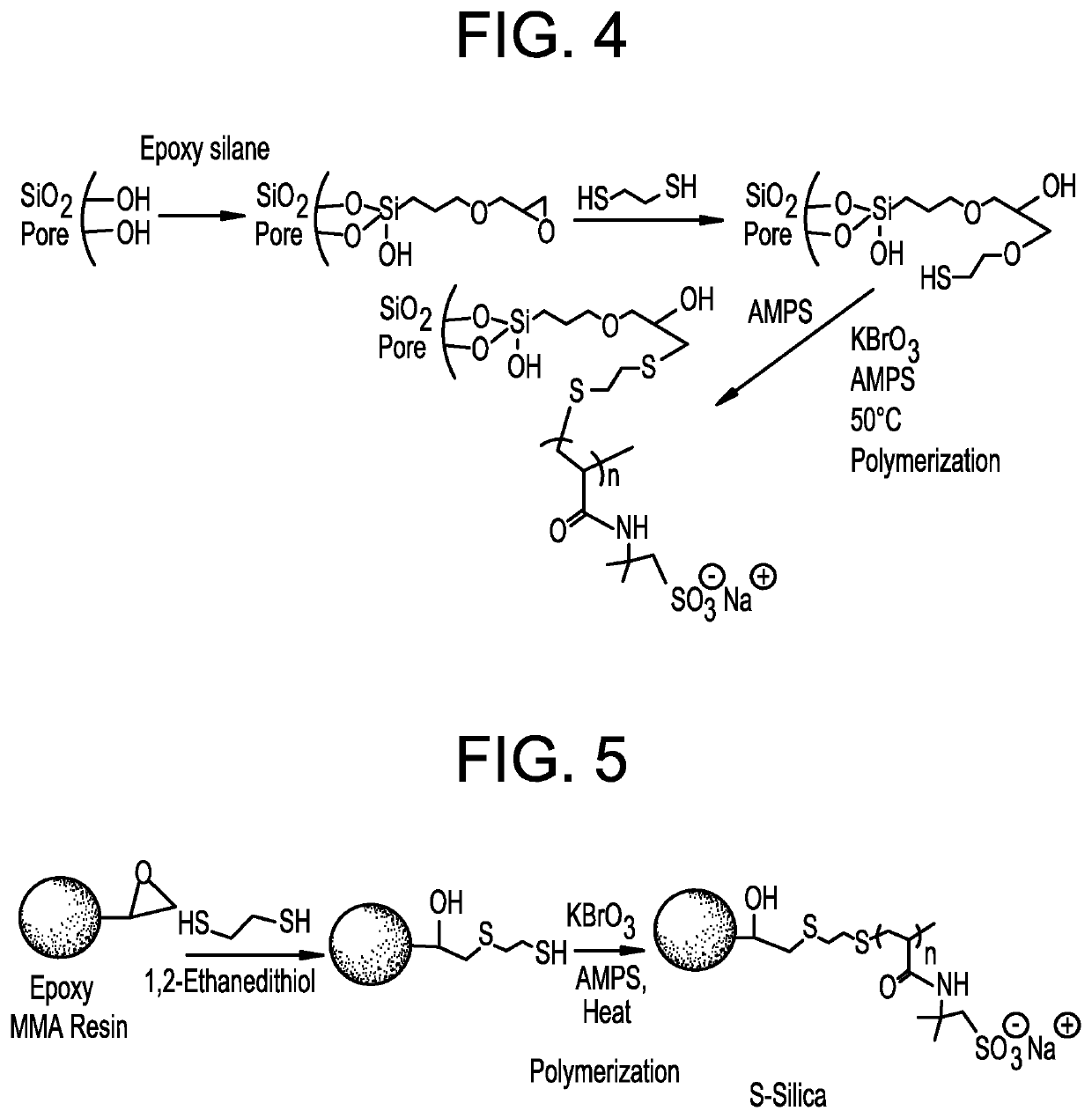Functionalized support material and methods of making and using functionalized support material
a functionalized support material and functional technology, applied in the field of functionalized support materials, can solve the problems of high mw biomolecules not being able to reach the media surface in time, slow and limited diffusion of high mw biomolecules, and high cost of chemistry both raw materials (monomer, ce salt) and processes,
- Summary
- Abstract
- Description
- Claims
- Application Information
AI Technical Summary
Benefits of technology
Problems solved by technology
Method used
Image
Examples
examples
[0106]The following examples described processes for modifying the surfaces of media, including silica and polymeric resins, using the thiol oxidation polymerization chemistry of the present invention. It should be noted that although silica and poly(methylmethacrylate) particles are used in the following examples, other types of particles (or other support materials as discussed above) and particle surfaces (or other support material surfaces) could be modified using similar process.
[0107]One example below relates to porous inorganic media, a silica based ion exchange material, formed via a process consisting of two main steps: (1) bonding of silica surface with thiol group containing methoxysilane to form an initially bonded intermediate; and (2) free radical polymerization of ionic monomer(s), through the introduction of oxidizing agents such as sodium bromate, in the presence of the initially-bonded silica intermediate to generate surface radicals. The surface radicals initiated...
examples 1-5
[0119]As shown in FIG. 2, two different routes were utilized to introduce polymer chains containing anionic sulfonic acid groups onto the surface of silica particles. The first route involved initial bonding of thiol groups by reacting (3-mercaptopropyl)trimethoxysilane (thiol silane), followed by polymerization. The second route involved two surface modifying silanes: (i) thiol silane and (ii) 2-[methoxy(polyethyleneoxy)propyl]-trimethoxysilane (PEG silane) available from Gelest, Inc.
[0120]The main benefit for the second route, as described in the examples, was that the initially bonded silica was more hydrophilic and could be washed with water, while for the first one, some organic solvent, such as methanol or acetone, was used for clean-up and removal of unreacted / unattached silane reagents.
Initial Bonding, Route 1
[0121]100 grams of silica was rolled and mixed with 5 grams of (3-mercaptopropyl) trimethoxysilane in a 2 L round bottom flask on a rotavap (i.e., a rotary evaporator) ...
example 6
[0127]The following example utilized a reaction scheme as shown in FIG. 3. 25 grams of initially bonded silica having a 1000 Δ median pore size, and a 75 μm average particle size was made as discussed above, but only thiol silane was used in the initial bonding step. (Elemental analysis of the bonded material showed that C=0.95%, S=0.53%.) The intermediate product (i.e., silica particles with thiol groups thereon) was mixed with 35 grams of (3-acrylamidopropyl)-trimethylammonium chloride (75% aqueous solution, available from TCI America), 2.31 grams of diallyldimethylammonium chloride (65% solution, available from Aldrich), and 200 ml of DI water in a 500 ml three necked round bottom flask using a setup as described in Examples 1-5.
[0128]After removing air from the system with nitrogen bubbling for 20 minutes, 1.0 grams of potassium bromate was added. The mixture was stirred and gradually heated to 65° C. and reacted at 65° C. for 2 hours. After the reaction, the mixture was cooled ...
PUM
| Property | Measurement | Unit |
|---|---|---|
| diameter | aaaaa | aaaaa |
| average particle diameter | aaaaa | aaaaa |
| particle diameter | aaaaa | aaaaa |
Abstract
Description
Claims
Application Information
 Login to View More
Login to View More - R&D
- Intellectual Property
- Life Sciences
- Materials
- Tech Scout
- Unparalleled Data Quality
- Higher Quality Content
- 60% Fewer Hallucinations
Browse by: Latest US Patents, China's latest patents, Technical Efficacy Thesaurus, Application Domain, Technology Topic, Popular Technical Reports.
© 2025 PatSnap. All rights reserved.Legal|Privacy policy|Modern Slavery Act Transparency Statement|Sitemap|About US| Contact US: help@patsnap.com


